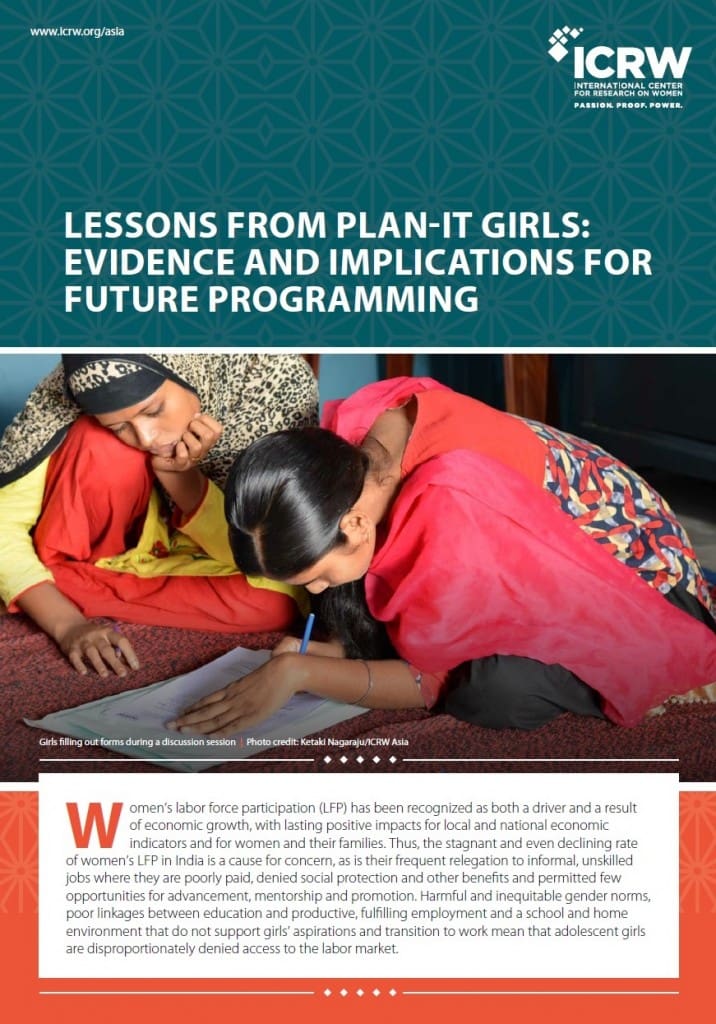
Lessons Learned from Plan-It Girls: Evidence and Implications for Future Programming
Adolescent Girls, Adolescents and Youth, Economic Opportunity & Security, Education, Employment and Enterprises
2021
Women’s labor force participation (LFP) has been recognized as both a driver and a result of economic growth, with lasting positive impacts for local and national economic indicators and for women and their families. Thus, the stagnant and even declining rate of women’s LFP in India is a cause for concern, as is their frequent relegation to informal, unskilled jobs where they are poorly paid, denied social protection and other benefits and permitted few opportunities for advancement, mentorship and promotion.
Harmful and inequitable gender norms, poor linkages between education and productive, fulfilling employment and a school and home environment that do not support girls’ aspirations and transition to work mean that adolescent girls are disproportionately denied access to the labor market.
Approach, Model, and Partnership
The Plan-It Girls program utilized a gender-transformative approach and an ecological model to improve adolescent girls’ agency, equip them with the attitudes, skills and aspirations and build a gender equitable environment around them to enable them to confidently enter and stay in the labor force and make decisions related to education and employment.
The program was implemented over two years in partnership with Restless Development and Pravah in two sites in India: Delhi and Jharkhand. Ten schools were selected for participation in Delhi and in two districts of Jharkhand: Deoghar and Pakur.
The Plan-It Girls’ ecological model placed girls at the center and implemented key curated activities for girls themselves but also for other actors, including adolescent boys, teachers, mothers, and community members.
Key Takeaways
1. The ecosystem approach and gender-transformative model of the Plan-It Girls program successfully shifted select empowerment and employability indicators for adolescent girls in Delhi and Jharkhand but impacts varied by age and location.
2. The model improved girls’ self-perception (self-efficacy and self-esteem) across cohorts.
3. Gender attitudes improved among girls in both age cohorts in the urban site.
4. Engagement with various stakeholders — male peers, parents, teachers and community members contributed in building a supportive environment for adolescent girls.
5. Facilitators with backgrounds similar to the participants acted as role models, which was important to the success of the program.
Implications for Future Programming and Research
The results of the quantitative impact evaluation and complementary qualitative study suggest that Plan-It Girls was able to improve adolescent girls’ self-perceptions and develop awareness of key gender concepts, equip girls with the skills and aspirations necessary for transition to work and promote a safe and positive school, family and community environment in which girls can thrive. The lessons learned from this research can offer guidance to implementers of similar programs in the future.
The research reported in this publication has been conducted as part of the Plan-It Girls program. Plan-It Girls is being implemented by ICRW Asia, in partnership with Restless Development and Pravah, in close association with the Government of Delhi and Government of Jharkhand with financial support from the Bill and Melinda Gates Foundation. The facts and information in this report may be reproduced/quoted/cited only for non-commercial use and with appropriate attribution.
.

